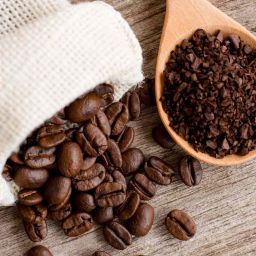
Cold brew coffee, known for its smooth and mellow flavor profile, has become a staple in the coffee enthusiast’s repertoire. Unlike traditional brewing methods that rely on hot water, cold brew is crafted by steeping coffee grounds in cold water over an extended period.
This process not only reduces the acidity and bitterness often associated with hot brewed coffee but also highlights the unique characteristics of the coffee beans used. The choice of coffee beans is paramount in cold brewing, as it significantly influences the taste, aroma, and overall enjoyment of the coffee.
Selecting the right beans can transform a simple beverage into an exquisite cold brew experience, making it crucial for aficionados to choose wisely.
Best Coffee Beans for Cold Brew
African Beans
African coffee beans are celebrated for their bright and fruity flavors, making them an excellent choice for cold brew coffee. These beans, particularly from regions like Ethiopia and Kenya, are known for their vibrant acidity and aromatic floral notes, such as jasmine or bergamot, which can result in a refreshingly complex and layered cold brew.
Latin American Beans
Beans from Latin American countries, including Colombia, Brazil, and Guatemala, offer a balanced and nutty profile that complements cold brewing.
Colombian beans are often highlighted by their mild, fruity flavors, while Brazilian beans may introduce a chocolaty and smooth character to the cold brew. Guatemalan coffee, on the other hand, tends to bring spicy and chocolatey notes, adding richness and depth to the brew.
Asian Beans
The robust and full-bodied beans from Asian regions, especially Indonesia and Vietnam, add an earthy and spicy dimension to cold brew coffee.
Indonesian Sumatran beans, for example, are known for their earthy, spicy, and sometimes smoky flavors, offering a bold taste that can stand up to the cold brew process. Vietnamese beans contribute a strong and distinctive robustness, making for a potent and adventurous cup.
Each origin brings its unique set of flavors and aromas to the table, directly influencing the cold brew’s final taste profile. By understanding these nuances, coffee lovers can tailor their cold brew experience to suit their individual preferences, ensuring a satisfying and enjoyable cup every time.
Top Picks for Cold Brew Coffee Beans
Stumptown Hair Bender
Stumptown Hair Bender is a versatile coffee blend that is well-suited for various brewing methods, including cold brew. It features a complex flavor profile with notes of dark chocolate and citrus, providing a rich and nuanced cup that can appeal to a wide range of palates. This blend, comprising beans from Africa, Latin America, and Indonesia, is roasted in small batches to ensure its full potential is unleashed, making it a favorite among coffee enthusiasts.
Peet’s Coffee Baridi Blend
Peet’s Coffee Baridi Blend is a medium roast specifically crafted for cold brew coffee. Originating from East Africa, this blend offers a symphony of sweet, fruity, and floral notes that come alive in cold water. The Baridi Blend’s natural flavors are perfectly suited for cold brewing, resulting in a crisp, clean cup with lingering floral notes, making it an excellent choice for those starting their cold brew journey.
Volcanica Coffee
Volcanica Coffee’s Ethiopian Yirgacheffe beans are a testament to the brand’s commitment to quality and flavor. Known for its floral and lavender notes, complemented by hints of blueberries and dark chocolate, this medium roast is a delight for cold brew lovers seeking a distinct and refined taste profile. Volcanica Coffee ensures that each batch is freshly roasted, highlighting the unique characteristics of Ethiopian beans.
Kicking Horse Coffee Smart Ass Medium Roast
Kicking Horse Coffee offers the Smart Ass Medium Roast, a certified organic and fair-trade option that brings together the best of African, Central, and South American beans. This coffee presents a harmonious blend of sugar cane and milk chocolate notes, with subtle hints of tart red currant and honeyed berry, creating a versatile coffee that can be enjoyed in various brewing methods, including cold brew.
Lavazza Classico Whole Bean Coffee
Lavazza Classico Whole Bean Coffee is an affordable option that doesn’t compromise on quality or flavor. This full-bodied blend, featuring beans from South America and Africa, offers a rich aroma and flavor profile that’s perfectly suited for cold brew.
The Classico blend fills your kitchen with a dried fruit and coffee bean aroma upon grinding, and its richness carries through to the chilled beverage, providing a satisfying and budget-friendly choice for cold brew aficionados.
Each of these coffee beans has been carefully selected to enhance the cold brew experience, offering a range of flavors and profiles to suit different tastes and preferences. Whether you prefer a rich and complex cup or a light and floral brew, there’s an option here that’s sure to elevate your cold brew game.
Grinding for Cold Brew
Ideal Grind Size
For cold brew coffee, the grind size of the beans plays a crucial role in the extraction process. A coarse grind is recommended, akin to the texture of coarse sea salt.
This size allows for optimal extraction over the extended brewing period typical of cold brew, preventing over-extraction that could result in a bitter taste. A consistent and uniform coarse grind ensures that the water flows through the coffee grounds evenly, extracting flavors effectively and producing a smooth, well-balanced cup.
Blending Beans
Blending beans from different regions can offer a unique and complex flavor profile for cold brew coffee. By combining the bright and fruity notes of African beans, the nutty and balanced flavors of Latin American beans, and the earthy, spicy characteristics of Asian beans, coffee enthusiasts can create a cold brew that is both nuanced and satisfying.
Experimenting with blends allows for customization of flavor, enabling individuals to craft a cold brew that caters to their specific taste preferences.
Brewing Techniques and Tips
Brewing Time and Ratios
The ideal brewing time for cold brew coffee ranges from 12 to 24 hours, depending on the desired strength and flavor concentration. A common coffee-to-water ratio for cold brew is 1:8, meaning one part coffee to eight parts water, though this can be adjusted based on personal preference.
This ratio strikes a balance between strength and flavor, producing a cold brew that is both robust and refreshing. Adjusting the brewing time or ratios can result in a brew that is lighter or more concentrated, catering to the individual’s taste.
Storage and Freshness
Proper storage of both coffee beans and the brewed coffee is essential for maintaining freshness and flavor. Coffee beans should be stored in a cool, dark place in an airtight container to preserve their quality. Once brewed, cold brew coffee can be stored in the refrigerator for up to two weeks, although consuming it within the first week is recommended for the best flavor.
Using airtight containers for the brewed coffee minimizes exposure to air, which can degrade the quality and taste of the cold brew over time.
By focusing on the essentials of grinding, blending, brewing, and storage, coffee lovers can elevate their cold brew experience, ensuring every cup is as delicious as the last. Experimenting with grind sizes, bean blends, brewing times, and ratios can lead to the discovery of new and exciting flavor profiles, making the cold brew process both an art and a science.
FAQs
What are the best beans for adding milk to cold brew?
For adding milk to cold brew, dark roast beans are generally recommended. Their bold, robust flavors complement the creaminess of milk better than lighter roasts, ensuring the coffee’s character remains prominent. A ratio of three parts coffee to one part milk or cream is a good starting point for those experimenting with milk in their cold brew.
What is the best grind for cold brew coffee?
The ideal grind for cold brew is coarse, similar in texture to coarse sea salt. This grind size allows for a slow and even extraction, which is crucial for the cold brew method. A coarse grind prevents over-extraction, avoiding bitterness, and ensures a smooth, flavorful cup of cold brew.
Is special coffee needed for cold brew?
No, special coffee is not strictly needed for cold brew. However, using freshly roasted, coarsely ground beans can significantly enhance the flavor of your cold brew. The choice of bean origin and roast level can vary based on personal taste preferences, with some opting for single-origin beans for their distinct flavors and others preferring blends for a balanced cup.
Conclusion
Throughout this exploration of the best coffee beans for cold brew, it’s clear that the choice of beans profoundly impacts the final brew’s quality. From the vibrant and fruity African beans to the balanced and nutty flavors of Latin American beans, and the earthy, spicy notes from Asian origins, each brings its unique characteristics to the fore.
The versatility of Stumptown Hair Bender, the artisan craft of Peet’s Coffee Baridi Blend, the distinct profile of Volcanica Coffee, the organic and fair-trade quality of Kicking Horse Coffee, and the affordability and richness of Lavazza Classico Whole Bean Coffee illustrate the wide array of options available to enthusiasts.
The cold brew process, from grinding to brewing and storage, demands attention to detail to achieve the perfect cup. A coarse grind, the right coffee-to-water ratio, and proper storage practices are essential components that ensure freshness and flavor are preserved from bean to cup.
This journey into the nuances of cold brew coffee underscores the importance of experimentation. By exploring different beans, grinds, and brewing times, coffee lovers can tailor their brewing process to suit personal preferences, discovering new flavors and profiles that resonate with their palate. The exploration of cold brew coffee is a testament to the beverage’s versatility and the endless possibilities that await those willing to dive into its depths.








